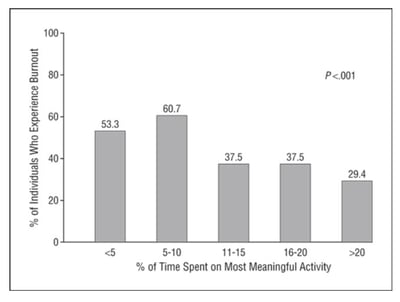You know the Pareto Principle either by that name or by its more common expression: The 80:20 Rule
Turns out that the Pareto Principle applies to Physician Burnout. We even have a study to prove the point.
Let me break down the research and potentially show you how to put Pareto to work for your own wellbeing.
~~~~~~~~~~~~~~~~~~~~~~
Time To RESET Your Practice ?
START HERE
~~~~~~~~~~~~~~~~~~~~~~
The Pareto Principle:
Also known as the 80/20 rule, or the ‘law of the vital few and trivial many,’ the Pareto Principle names the general observation that 80% of effects or outcomes come from 20% of causes or inputs.If you look around at your own general experience of life, you will often find 80% of any result is produced by 20% of the participants in generating the result.
- 80% of sales come from 20% of buyers
- 80% of the Halloween candy comes from 20% of the houses in the neighborhood
Once you start looking for it, you will find the Pareto principle everywhere.
What if the Pareto Principle applies to Physician Burnout too?
Here's the Research
Career Fit and Burnout Among Academic Faculty
Tait D. Shanafelt, MD et al
Arch Intern Med. 2009;169(10):990-995.
Download a full PDF Copy at This LinkIn this study of 465 academic physicians, the research team divided their academic practice into four broad categories of professional activity:
- Research
- Education
- Patient Care
- Administration
Then they asked four very important questions
Q1: "Which of these four is YOUR FAVORITE activity?"
Here is the breakdown
- Research = 19%
- Education = 9%
- Patient Care = 68%
- Administration = 3%
Q2: "How much of your time at work do you get to spend in your favorite activity, in percent?"
Q3: "What is your current level of burnout?" Measured using the Maslach Burnout Inventory
Put all of this together and you get the Payoff Question
Q4: "How much time does an academic physician need to spend in their favorite part of their practice to minimize burnout?" Is there a dose response and where is the break point?
~~~~~~~~~~~~~~~~~~~~
The Tools and Support to be an Effective Wellness Champion
The Quadruple Aim Physician Leadership Retreat
~~~~~~~~~~~~~~~~~~~~
The Short Answer is 20%
We have seen that number before. Is this an expression of the Pareto Principle too?
Here's the graph of their results:

Let's break it down:
- Overall, 156 faculty members (34.0%) were burned out.
Note the study date is 2009. This is before the real bite of EMR and InBox overwhelm and COVID. These burnout rates are much higher today.- The most burned out were those at 5 - 10%.
They get just an occasional taste of their favorite bit ... just enough to remind them this is why they chose to be an academic in the first place - and no more. Ouch!- Burnout bottomed out at 20% and did not fall further with more time spent in the favorite activity. As if the dose response curve ended at the Pareto level of 20%.
Here are the specific findings:
- Physicians who spent at least 20% of their time in the aspect of work that was most meaningful to them had a rate of burnout roughly half that of those who spent less than 20% effort in the activity that was most meaningful to them.
- The association between time spent in the most meaningful activity and burnout was strong and was the largest predictor of burnout on multivariate analysis after other factors were controlled for.
Is this finding an expression of the Pareto Principle?
Let's go deeper:
NOTICE: The relationship is drawn between time spent in your favorite activity and burnout.
This study was not built to measure positive outcomes such as happiness, satisfaction, fulfillment or engagement. It's only measure is the presence or absence of burnout.
I suppose Pareto might say this:
20% of your practice activities have the ability to minimize burnout in the remaining 80% of your practice - if they are aligned with your favorite aspect of your job.
And this question is screaming in my head:
What if they had measured happiness, satisfaction, fulfillment and engagement instead?
Would those factors have topped out at the 20% of what I love about my practice ratio?
This point is very important because this study is often mis-quoted by senior leaders.
Here is how I have heard this study interpreted by senior leaders:
"Research shows you don't have to give doctors any more than 20% of their time on what they like about their job."
Now THAT is an evil twist isn't it?
And I believe this study does show us a way forward to minimizing burnout. I do not recommend you relax at the 20% threshold. How about you shoot for 80% and see how you feel then?
QUESTIONS FOR YOU:
===================
- What is your favorite part of your current job/practice?
- How much time - in percent - do you get to spend in that activity? If you don't know, you may want to log your next couple of weeks at work to find out?.
- What could you do to devote just a little more time and energy to what you love about your practice in the week ahead?
- What is your first action step?
- When will you take it?
PLEASE LEAVE A COMMENT:
What did you learn in this article?What new action will you now take?

